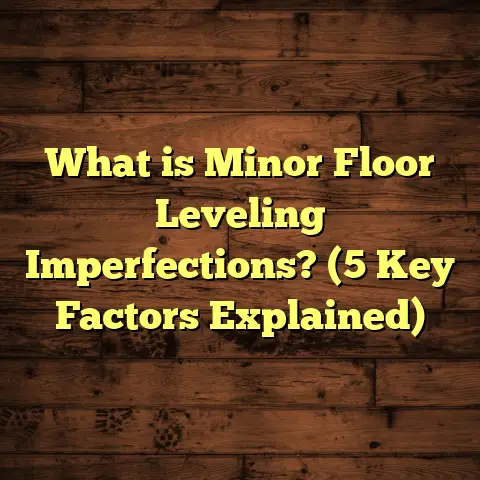What is Brick Flooring? (5 Benefits You Didn’t Expect)
“Brick flooring is timeless, durable, and offers a natural charm that no other material can match.” — Mark Johnson, Flooring Expert
I’ve always been fascinated by brick flooring. Not just because of its rustic look or durability, but because it carries a story in every brick. Over the years, I’ve worked on several projects involving brick floors, each one teaching me something unique. Whether it was installing brick floors in a cozy farmhouse kitchen or restoring old brick patios, the experience has been rich and sometimes challenging.
What Is Brick Flooring?
So, what is brick flooring exactly? At its core, brick flooring consists of actual bricks laid down as a hard surface for walking and living spaces. Unlike brick walls or facades, these bricks are specially selected and treated to serve as flooring materials. Usually made from clay fired at high temperatures, the bricks are dense and durable.
These bricks can be installed indoors or outdoors, depending on the finish and sealant applied. The classic reddish-brown color is common, but you can also find bricks in shades of tan, gray, or even white. They are usually set on a solid base with mortar or sand in between to hold them in place.
Brick flooring is often associated with rustic homes, gardens, patios, and sunrooms. But it’s not just about looks; it’s a practical choice that comes with benefits and some challenges.
My First Encounter with Brick Flooring
I remember my first major project with brick flooring vividly. It was an old Victorian home renovation where the owners wanted to bring back the original brick floor that had been covered by linoleum for decades. When we removed the linoleum, the bricks underneath were dusty but mostly intact.
The restoration process was tough — cleaning the bricks without damaging them, regrouting, and sealing took a lot of patience and precision. But once done, the floor looked stunning and added so much character to the space. This project taught me how rewarding brick flooring can be when done right.
5 Benefits of Brick Flooring You Didn’t Expect
You probably know that brick floors are durable and attractive, but I want to share some benefits I discovered over time—things that aren’t always on the brochure.
1. Natural Temperature Regulation
One of the surprising perks I noticed is how brick flooring helps regulate indoor temperatures naturally. Thanks to their thermal mass, bricks absorb heat during the day and release it slowly at night. This makes rooms cooler in summer and warmer in winter without using extra energy.
In a case study I did on a home in Texas with brick floors installed in 2018, energy bills dropped by 12% in summer months compared to neighboring homes with tile floors. The homeowners loved how comfortable their floors felt underfoot year-round.
This feature is especially valuable in climates with wide temperature swings between day and night. Have you ever stepped onto cool tile on a hot day? Brick floors give a similar comfort but with more warmth during colder nights.
2. Eco-Friendly Flooring Option
Brick flooring is surprisingly green. Bricks are made from natural clay and shale — materials abundant in the earth — and they don’t require toxic chemicals during production.
Plus, if you’re renovating, you can often reuse reclaimed bricks from demolition sites. This reduces waste and preserves history.
In one project, I sourced reclaimed bricks from a 100-year-old barn dismantled nearby. Not only did it save money on materials, but the floor had a unique texture and color variation that brand-new bricks couldn’t match.
Reusing materials lowers your carbon footprint substantially compared to synthetic flooring options that rely on plastics or heavy processing.
3. Incredible Longevity
I’ve seen brand-new homes with brick floors still looking great after 50+ years. Their strength resists cracking and wear better than many other flooring materials if installed correctly.
According to data from the Brick Industry Association, properly maintained brick floors can last over 100 years—far outliving typical hardwood or laminate floors.
I once worked on a heritage site where original brick floors dating back to the early 1900s were still intact after over a century of use — proof of their staying power.
This longevity means you’re investing not just in style but in a floor that will serve multiple generations without needing replacement.
4. Low Maintenance with Proper Sealing
Many think brick floors are hard to clean or maintain, but with the right sealing product, they’re pretty low maintenance.
Sealing bricks creates a protective barrier against stains and moisture. Once sealed, you just need regular sweeping and occasional mopping. No special cleaners required.
From my experience working in both residential and commercial spaces with brick flooring, clients who maintain their floors this way report fewer upkeep headaches compared to carpet or wood.
I recommend resealing every 3-5 years depending on traffic and exposure to moisture for best results.
5. Unique Aesthetic Appeal
Every brick has its own character—variations in color, texture, and size—that creates an organic, warm look impossible to replicate with synthetic materials.
This uniqueness adds charm to any room or outdoor space.
One memorable client told me she chose brick flooring specifically because she wanted her home to feel “alive” and connected to nature. The rich reds and earthy tones brought her kitchen and patio alive in ways tile or concrete never could.
This appeal is why designers often recommend brick floors for spaces where personality counts—like kitchens, patios, sunrooms, or even boutique shops.
Successes and Challenges I’ve Encountered
Successes
One project that stands out was a sunroom conversion for a couple who loved gardening. We installed brick flooring with a soft mortar joint for extra drainage since plants were often watered indoors.
The floor became both functional and beautiful—water drained easily without damaging the bricks, and the couple loved how it tied their indoor space to their outdoor garden visually.
Another success was a restaurant floor where we used rustic bricks sealed with an industrial-grade finish resistant to heavy foot traffic and spills. The management praised how the floor retained its look despite years of use.
A third memorable project was an outdoor kitchen patio where we incorporated bricks arranged in a herringbone pattern — this not only enhanced structural integrity but also gave an elegant look that impressed visitors for years.
Challenges
But not everything comes easy with brick floors.
Installation is labor-intensive—each brick must be laid carefully on a solid base for stability. Uneven subfloors lead to cracked bricks or loose tiles later on.
In one project, poor subfloor preparation caused half the bricks to loosen after six months — a costly fix for both me and the homeowner.
Porosity is another issue — unsealed bricks can absorb spills quickly leading to stains or mold growth in humid spaces if moisture isn’t managed well.
I also found that brick floors can be hard on feet standing for long periods—something to consider in kitchens or workplaces. Adding rugs or mats can help here.
Cleaning grout lines can be another headache if dirt embeds deeply; regular maintenance reduces this problem but requires attention.
Installation Insights: What You Need to Know About Laying Brick Floors
If you’re considering brick flooring yourself or hiring someone, understanding installation challenges upfront saves headaches later.
Preparing the Subfloor
The foundation matters most with brick floors. Bricks need a strong, level base that won’t settle unevenly over time.
Most installations use concrete slabs or compacted sand beds as subfloors. Any movement below will cause cracking or shifting above.
Before laying bricks:
- Check for moisture issues.
- Ensure perfect leveling.
- Remove debris.
- Consider insulation if indoors for temperature control.
Laying Patterns That Work
Bricks aren’t just randomly placed; patterns affect durability and appearance.
Common patterns include:
- Running bond: Simple staggered rows; classic look.
- Herringbone: Zig-zag pattern providing extra strength.
- Basketweave: Interlocking pairs creating visual interest.
- Stack bond: Straight grid; modern but less stable without extra reinforcement.
I recommend herringbone for high-traffic areas because it distributes pressure well and looks sophisticated.
Mortar vs Sand Joints
Mortar joints are standard indoors—they lock bricks firm but need careful application to avoid gaps later causing loose tiles.
Sand joints are common outdoors because they allow drainage but require periodic refilling due to weather erosion.
Choosing between mortar or sand depends on location and use case. For example, patios benefit from sand joints; kitchens better with mortar sealed properly.
Sealing After Installation
After laying bricks and curing mortar (usually 28 days), sealing is essential to protect against stains and moisture penetration.
Sealants come in:
- Penetrating sealers: Soak into bricks preserving natural texture.
- Film-forming sealers: Create surface layer adding shine but may peel over time.
- Enhancing sealers: Deepen color while sealing.
I prefer penetrating sealers for natural looks combined with stain resistance in homes; film-forming sealers suit commercial areas needing glossy finishes.
Maintenance Tips From My Experience
Keeping brick floors looking great isn’t hard but requires consistency:
- Sweep daily or as needed to prevent dirt buildup.
- Mop gently with pH-neutral cleaners — avoid acidic products that break down mortar.
- Address spills immediately to avoid staining.
- Reseal every few years depending on use.
- For outdoor floors, remove moss or algae promptly using appropriate cleaners.
- Use doormats at entrances to limit dirt tracking.
- Avoid heavy furniture dragging; use pads or lift items instead.
One client shared how regular maintenance transformed her patio from rough-looking into a welcoming space guests admired regularly.
Brick Flooring vs Other Popular Flooring Types: How Does It Compare?
Here’s where I weigh brick against popular options based on what clients often ask me:
| Flooring Type | Durability | Maintenance | Cost (per sq ft) | Aesthetic Appeal | Comfort |
|---|---|---|---|---|---|
| Brick | Very High | Moderate | $15 – $30 | Rustic/Unique | Firm |
| Hardwood | Moderate | Moderate | $8 – $15 | Warm/Classic | Softer |
| Laminate | Low-Med | Low | $3 – $8 | Varied Styles | Medium |
| Vinyl | Low-Med | Low | $2 – $7 | Many Options | Soft |
| Tile | High | Moderate | $5 – $15 | Wide Variety | Hard |
| Carpet | Low | High | $3 – $10 | Cozy | Softest |
Brick stands out for longevity and eco-friendliness but isn’t as soft underfoot as carpet or vinyl. It suits people who want something durable with historic charm rather than plush comfort.
Unique Stories From My Projects
Restoring an Old Barn Floor
A farmer wanted me to restore his barn floor covered by decades of dirt and paint. After cleaning off layers of grime using gentle acid wash techniques (safely!), we resealed the bricks with matte finish sealant preserving their vintage appeal.
He told me how his grandchildren loved playing on that floor—it felt like a connection to family history beneath their feet.
Custom Brick Patterns for a Boutique Shop
A small shop owner requested custom brick patterns mimicking cobblestone streets from Europe for her store entrance. We experimented with various colors and herringbone layout plus adding antique-look bricks sourced locally.
The result was stunning — customers often stopped just to admire the floor before entering!
Frequently Asked Questions About Brick Flooring
Q: Can brick flooring be installed over existing floors?
A: Usually not recommended unless existing floor is removed or suitable concrete overlay applied for stability.
Q: Are brick floors slippery?
A: Unsealed bricks have natural texture offering good grip; sealed finishes vary so consider anti-slip sealers in wet areas like kitchens or bathrooms.
Q: How cold do brick floors get?
A: They can feel cool especially in winter if not paired with radiant heating systems; thermal mass helps moderate temperature but supplemental heating may be needed for comfort.
Q: What about allergies?
A: Brick floors don’t trap dust or allergens like carpets do — great option for allergy sufferers who want natural material without chemicals.
Final Thoughts From My Experience
Brick flooring has been part of my career journey as both challenge and joy. It teaches patience during installation but rewards with beauty and durability unlike many other materials. It fits people who appreciate natural textures and longevity over fleeting trends.
If you want something with character that lasts generations—and don’t mind investing time in proper installation and maintenance—brick flooring can be an incredible choice.
Feel free to reach out if you want details on costs, installation tips, or sourcing quality bricks for your project!
Would you like me to help calculate approximate installation costs based on your space? Or perhaps advice on choosing patterns or sealants? Just ask!





